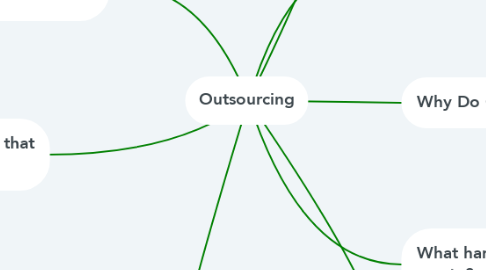Outsourcing
by Jon Iantsevitch

1. What is Outsourcing?
1.1. Outsourcing is the practice of hiring a party outside of an organization to perform services or to manufacture goods.
2. Why Do Companies Outsource?
2.1. A company usually chooses to outsource in an effort to create a cheaper alternative for manufacturing compared to a company deciding to do so within its own company.
3. Who benefits the most from outsourcing?
3.1. Usually the parent organization receives the most benefits as they receive more profits and less labor.
4. What are the opportunities that arise from outsourcing?
4.1. Outsourcing creates opportunities such as increased flexibility in deadlines and workloads in a company, better strategic focus, and the ability to share risks instead of having them localized in an company.
5. What are the risks involved with outsourcing?
5.1. Outsourcing can create challenges for a company such as the erosion of customer satisfaction if a job is done poorly, political changes such as a change in employment laws, and privacy issues and the risk of a privacy breach.
6. What harm can outsourcing create?
6.1. Outsourcing usually doesn't create much of any harm immediately but over time the effects of outsourcing can be troubling. These issues include but are not limited to: Increased competition, less jobs and it can affect insourced countries such as China.
7. Challenges associated with outsourcing
7.1. Outsourcing can create challenges for a company such as the erosion of customer satisfaction if a job is done poorly, political changes such as a change in employment laws, and privacy issues and the risk of a privacy breach.
8. Personal Conclusion
8.1. Outsourcing is an effective way to reduce the workload in a company that comes with a variety of benefits and issues as any shortcut with business does.


